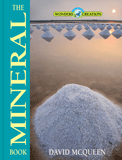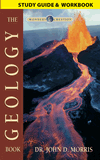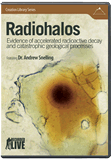Shape-Shifting Silicon
Semi-Technical
We need dirt and rocks for more than gardens and landfills. They also supply our industries and beautify our homes. God designed the same basic building block—silicon—to morph into all these materials, and much, much more.
Rob Lavinsky, irocks.com
The exotic shapes and vivid colors of crystals are often what first attract the wonder of children and draw them into studying geology. That’s what happened to me. When I was nine years old on a family vacation in Tasmania—the island state off Australia’s southeastern coast—I saw a piece of shiny mineral on a mine’s waste pile. I was instantly hooked. I eagerly talked about this treasure at my next grade four “show and tell” session, and this chalcopyrite (copper ore) became the first member of my rock and mineral collection.
So why do minerals have so many different shapes and colors? The answer tells us a lot about God’s love and care for us. He created a small set of basic building blocks, out of which the earth could provide the amazing variety of minerals we need to build places to live and grace our lives with beautiful gems.
The marvelous stability and interlocking properties of minerals, which have such an amazing variety of applications—from the yellow paint on our kitchen walls to the glass in our windows—point clearly to the handiwork of the Creator, who “formed the earth . . . to be inhabited” (Isaiah 45:18).
The Crucial Role of Silicon Atoms
The earth’s crust is composed of many different elements, but 75% of the crust consists of just two elements: silicon and oxygen. These are the basic building blocks of the ground under our feet.
Nearly 92% of the earth’s crustal rocks are composed of silicate minerals.
When isolated, silicon is invaluable to modern life. For instance, it’s the basic ingredient in computer chips. Imagine that—the most important element in modern technology is the most common on the planet (apart from oxygen).
When silicon combines with oxygen, the true marvel of its versatility shines. Out of nearly 5,000 minerals known to exist, over 25% are silicates (minerals whose crystals are composed of arrays of atoms based around silicon atoms). Silicate minerals are so abundant that about 92% of the earth’s crustal rocks are made up of them.
How can so many shapes and colors come from just one element? The answer is its incredible ability to combine with other elements in many different ways. Like Tinkertoys, silicon can combine into rows, rings, sheets, or complex three-dimensional structures.
First, A Little Chemistry
Just as carbon is the basic building block of living things, silicon is the basic building block of the nonliving earth. To appreciate the wisdom behind their design, it’s necessary to understand a little basic chemistry.
Look closely at the Periodic Table of Elements (Figure 1). Silicon (symbol Si) is element 14 on the table, and is in the same column as carbon (C), element 6. Silicon and carbon are the only nonmetal elements in this column, with special properties that allow them to combine easily with other elements.
Both carbon and silicon atoms have spots for eight electrons in their outer shells, but only four of these spots are filled with their own electrons. This configuration enables other atoms to hook into the empty spots. Carbon, for instance, links together with oxygen, hydrogen, and other atoms to form the complex organic molecules of life, such as DNA.
In the same way, silicon has four electrons in its outer shell, which it readily shares with oxygen (O) atoms. Oxygen likes to fill all four empty spots, resulting in a triangular pyramid. The silicon atom is in the middle, and an oxygen atom sits at each of the four corners. This is an incredibly stable, flexible building material. The chemical formula is technically SiO4, and the formal name of this basic building block is the silica tetrahedron.
A Thousand Combinations, for Work and Pleasure
These little pyramid blocks of silica tetrahedra can be linked together and stacked in almost every imaginable combination. But geologists recognize six major classes: isolated, couplets, rings, chains, sheets, and frameworks (3D structures).
The different combinations make possible the multifaceted shapes of crystals. The colors are more complicated. Adding other elements produces different colors, though indirectly. The colors aren’t inherent in the atoms, but they change the way light passes through the minerals.
In most cases, the tetrahedra are formed out of silicon and oxygen atoms, but sometimes in some terahedra an aluminum atom is substituted for the silicon atom. Other major elements that frequently join the tetrahedra are iron, magnesium, sodium, potassium, calcium, and to a lesser extent titanium and manganese. Sometimes trace elements can join, too, like chromium, beryllium, lithium, and boron—producing interesting and colorful variations.
Changing the combination of elements gives each mineral not just new shapes and colors, but also new properties. In fact, the same elements can produce either cheap building materials or precious gems, depending on their arrangement. While this is not intended to be an earth science lesson, all believers should become familiar with a few highlights, which will enable them to share the glories of their Creator with people who don’t know Him.
Figure 2
Limitless Possibilities
God designed silicon to form a basic four-sided molecule with oxygen that would be the building block of earth. From this single molecule, called a silcon tetrahedron, God formed over two thousand minerals that are essential to modern life and industry.
photos thinkstockphotos.com and Rob Lavinsky, irocks.com
Single (Nesosilicates)
Let’s start simple. Single pyramids, or tetrahedra (Figure 2), can be linked by magnesium and iron atoms to form the dense, green mineral called olivine. God used this densely packed crystal to make “the foundations of the earth” (Job 38:4). Olivine is the major mineral in the earth’s mantle, which lies between the core and the outer skin or crust and is 1,796 miles (2,890 km) thick.1 Amazingly, olivine also comes in a gem variety, called peridot.
Another common mineral in this class is garnet. Its beautiful shape, called a dodecahedron, makes it a popular gem. These minerals would be clear if God had not designed them to combine with other elements. By His wise design, they produce many rich colors.
In this class is another famous mineral, the topaz. At 8 on a scale of 1 to 10, this densely packed gem is the third-hardest mineral.
Couplets (Sorosilicates)
Another class of silicate minerals consists of couplets (Figure 2) linked by calcium, aluminum, and iron atoms. Many minerals fall into this class, such as epidote and zoisite (see photos), but none are well-known.
Rings (Cyclosilicates)
Now it starts to get really interesting. Six silica tetrahedra can join into rings (Figure 2). The best-known mineral in this class is beryl, formed when the rings are linked together by beryllium and aluminum atoms. The six-sided rings produce distinctive six-sided crystals that can get really massive. The largest crystal ever discovered—of any type of mineral—is a beryl from Madagascar, 59 feet (18 m) long and 12 feet (3.5 m) in diameter.
Beryl is a source of beryllium, a lightweight metal used in special high-tech alloys. Beryl also comes in two beautiful gem varieties: emerald2 and aquamarine.
Chains (Inosilicates)
When the silica pyramids are joined together in single chains (Figure 2), they form an important class of minerals known as pyroxenes. The most prevalent example of these is the common black specks, called augite, which appear in basalt walls on buildings. Another variety of pyroxene, called jadeite, is a major source of the precious gem jade. This mineral is made by combining with sodium and aluminum. Think about this marvelous transformation: you get green jade by combining the silicon in computer chips with table salt (sodium) and aluminum!
If the silica building blocks are joined together in double chains (Figure 2), then they form a common type of mineral known as amphiboles. Many different varieties exist because five different atoms (magnesium, iron, aluminum, calcium, and sodium) can be used to link the double chains together. If all five atoms are involved, the result is hornblende, a common black mineral, sometimes found in granites. Another dual-chain mineral, called nephrite, provides another variety of jade.
The double-chain crystal structure can also produce long, thin fibers. That’s what happens in asbestos minerals. Once considered a cheap building material, asbestos was banned after doctors discovered the fibers can clog lungs. But these same fibers, if woven into cloth, are still used in fireproof clothing that protects our firefighters. Amazingly, one of the six asbestos minerals (riebeckite) produces the valuable “tiger’s eye” gem.
Sheets (Phyllosilicates)
Silica tetrahedra can also be joined into sheets (Figure 2). What good is a “sheet” of mineral? These sheets form three of the earth’s most common minerals—micas, talc, and clay minerals. All three are vital to industry.
The black mica (biotite) and the white mica (muscovite) are common in granites and metamorphic rocks, such as schists. Micas can be peeled apart like the pages of a book, so they’re not always good for building materials or gems.3 Muscovite sheets, because of their transparency and ability to withstand heat, were once used as windows in wood-burning heaters and stoves.
Another sheet silicate is talc. We get talcum (“baby”) powder from this mineral.
Common clays are also sheet silicate minerals. We call these “clay minerals” because they break down easily into clays. They have an abundance of uses. Kaolinite, for example, is a “filler” in glossy paper and house paints. When you buy paint at the store, an essential ingredient is sheets of silica and oxygen atoms connected by aluminum!
Frameworks (Tectosilicates)
The most elaborate form of silica tetrahedra is a three-dimensional structure called a framework (see diagram). These are the most abundant minerals in the earth’s crust, making up 63% of its rocks.
One example is quartz, whose chemical formula is SiO2. This mineral is the basis of the glass used in windows, bottles, and jars, and lately, fiber optics. It also comes in gem varieties, such as amethyst, agate, and opal.4
The other example of framework silica is feldspar. Along with building materials, this mineral is also useful in making glass, as well as soaps, cements, tar roofing, paper, and pottery. Unlike in quartz, which consists simply of silicon and oxygen, aluminum atoms must substitute for some silicon atoms in feldspar. This substitution results in an imbalance of the electron charge, which is compensated for by adding potassium atoms in alkali feldspar, or calcium and sodium atoms in plagioclase, to restore the balance. Plagioclase is actually the most common mineral on earth.
Conclusion
The silicate minerals make up most of the rocks on our home planet, Earth. God clearly designed them based on the silicon atom’s ability to form versatile pyramids, known as silica tetrahedra. The Creator wanted to make sure every child could wonder at the beauty of these minerals and eventually come to appreciate their strategic role in His creation and their practical uses.
Like me, many geologists’ interest in rocks and minerals was kindled as a child. Minerals display not only God’s incredible creativity and His care for our needs, but also His unbounded love of variety and beauty.
Related Videos
Minerals: by God’s Design
Answers Magazine
October – December 2014
This issue explores the marvelous human immune system. Plus take a look at the Creation Museum's new Allosaurus.
Browse Issue SubscribeFootnotes
- A. A. Snelling, “Journey to the Center of the Earth,” Answers 8.3 (July–September 2013): 72–75.
- A. A. Snelling, “Emeralds—Treasures from Catastrophe,” Answers 6.4 (October–December 2011): 72-75.
- But it’s easy to study micas under the microscope, and creationists have discovered amazing evidence of radiohalos in biotite that the earth’s minerals were created just a few thousand years ago; A. A. Snelling, “Radiohalos—Mysterious Bullet Holes in Rocks,” Answers 7.2 (April-June 2012): 70-73; A. A. Snelling, “Radiohalos—The Mysterious Vanishing Bullets,” Answers 7.3 (July–September 2012): 70–74; A. A. Snelling, “Radiohalos—Solving the Mystery of the Missing Bullets,” Answers 7.4 (October– December 2012): 70–73.
- A. A. Snelling, “Rapid Opals in the Outback,” Answers 9.3 (July–September 2014): 46–48.
Recommended Resources

Answers in Genesis is an apologetics ministry, dedicated to helping Christians defend their faith and proclaim the good news of Jesus Christ.
- Customer Service 800.778.3390
- © 2024 Answers in Genesis






